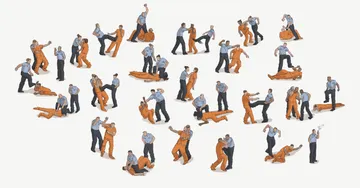This article was published in collaboration with Vice.
“Farm to Market Road 632.”
I have lived on that road for nearly 20 years, yet I’ve only set foot on it once. But if I am finally released — onto the strip of asphalt that connects Texas’ Connally Unit, where I am currently incarcerated, to civilization — I'm sure it will seem like the most beautiful highway in the history of mankind.
The one time I’ve seen it was when they assigned me to paint the parking stumps in the lot at the front of the prison. I was to designate the reserved spots for the upper echelon of prison staff: department heads, senior officials, any rank above sergeant.
It was a lesson in prison politics where the choicest spots — which I was told to decorate with painted outlines of the state of Texas and wooden blocks etched with their names — went to the wardens and majors.
Working “outside the fence” comes with extra security precautions. There was an armed “high-rider” officer tracking us in a golf cart, another unarmed officer directing us in our work, and the armed perimeter truck frequently circled around the unit. The sharpshooters in the towers seemed extra vigilant.
Before getting to work, three fellow prisoners and I were escorted through the back gate. A dead-faced officer (whom I later learned would be getting the parking spot on the far, far, right) strip-searched us. His lackadaisical approach to the task gave the impression that what he was doing was in the interest of humiliation, not security.
The four of us hopped into the back of a pickup truck and raced around the massive complex of concrete and steel cellblocks. After a decade and a half of not being in a moving vehicle, “raced” may have been an exaggeration, but the yellow stripes of each parking space seemed to shoot from under the rear bumper like lasers. It took at least three minutes to adjust to the sensation of moving while sitting still.
When I hopped off the truck, the world began to shimmer. After 17 years of always having a roof over my head, a wall or fence around me, and my peripheral vision obscured by bars, razor wire or chicken wire, I felt vertigo. The horizon, rolling on and on, made me feel as if I could spin off the earth.
The blue of the sky was more intense without obstruction. I could not believe I had ever lived in such a world.
Later on, halfway through painting the stylized flags, state outlines, and wardens’ names, I knelt to clean my brush. When I looked around to see what progress the other guys were making, I saw an unfamiliar face.
He wore a white, collared shirt that was much like my own except buttons held down the collar’s tips. He was also wearing boots with decent-looking soles, and brass, not steel, eyelets.
I went back to work, but a few moments later, the grey-haired entrance officer’s voice cut through the air. “Can ah help you?” she called out to the stranger.
Before he could answer, the rifle-toting high-rider officer zoomed up in his golf cart, muttered something with the other officers, then said to the rest of us, “Put everything down and go to lunch.” I was a little annoyed. My family had paid for all of my equipment; leaving it unattended in the prison’s parking lot seemed like a bad idea.
After 45 minutes, when we returned to work — our equipment still there — we heard what had happened. The inmate-looking man had actually been released from prison not long ago. He had been in solitary and had no television, no human contact. Psychosis — like the mixture of orange juice, sugar, and rotten bread we leave sitting in a bag to make hooch — ferments.
I don't know if the man from the parking lot had taken his sickness into Administrative Segregation (one official name for solitary, a.k.a. Ad Seg) or if he developed it there, but he definitely took it home.
Apparently, he desperately wanted to talk with the captain in charge of Ad-Seg, whom he believed had planted a microchip in his head. He was demanding the captain take it out.
The officers, armed with semi-automatic assault rifles and handguns, surrounded the man and shooed him away.
We are sent to prison because of an act, or series of acts, or suspicion of our potential to commit those acts. But when we leave here, our time inside exacts a toll.
If Farm to Market Road 632 ever takes me away from the Connally Unit, I pray the damage done never brings me back.
Carlos Flores, 40, is incarcerated at the John B. Connally Unit in Kenedy, Texas, where he is serving a life sentence for murder, which he was convicted of in 1999.

